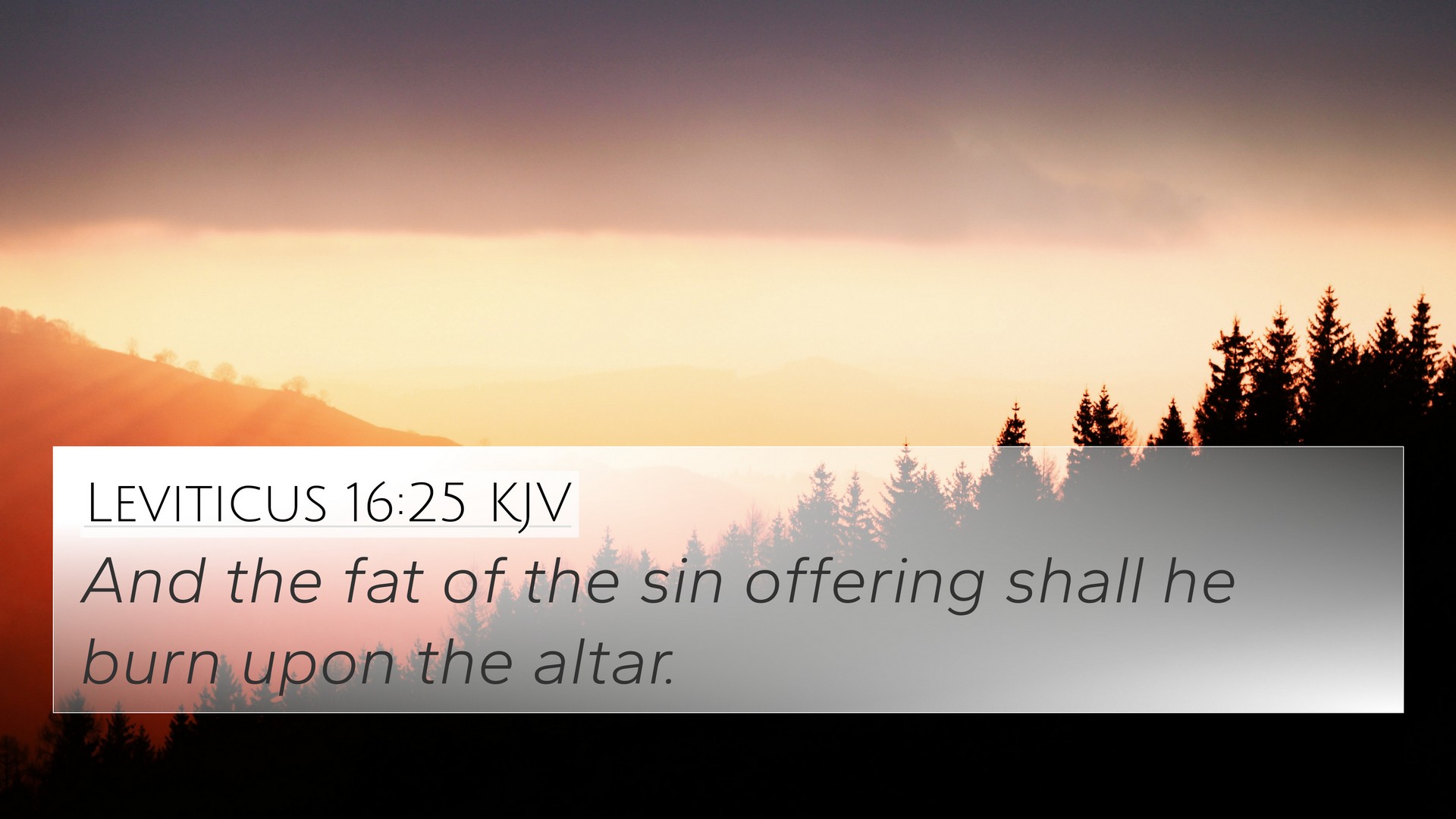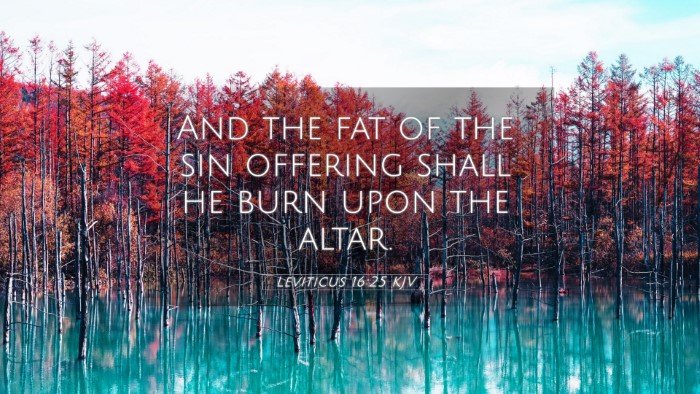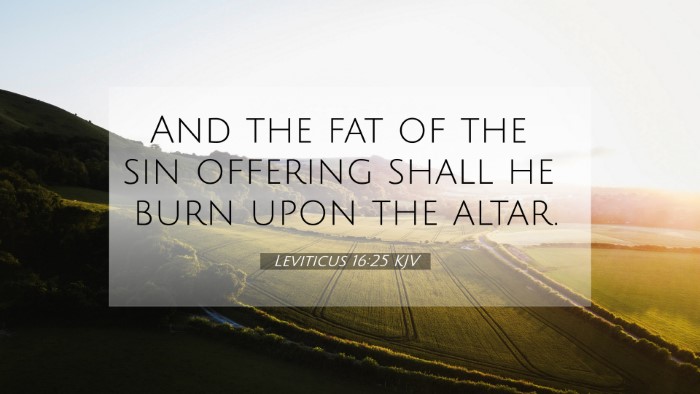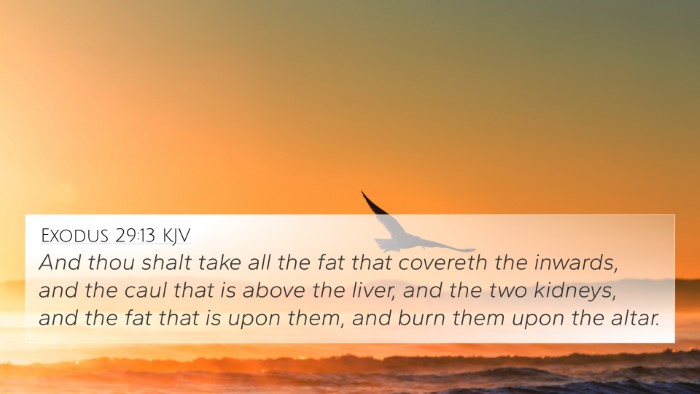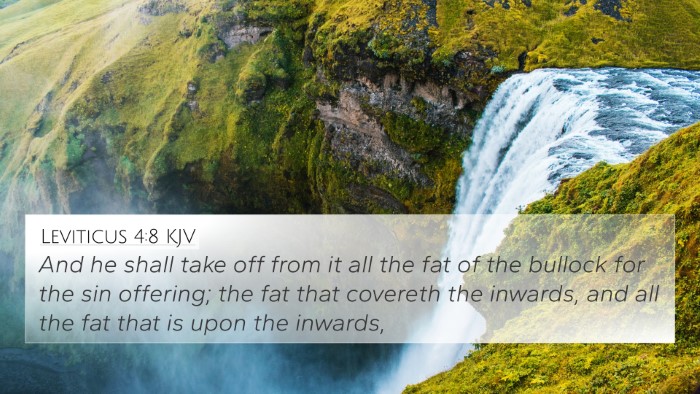Understanding Leviticus 16:25
Leviticus 16:25 states: "And the fat of the sin offering shall be burned on the altar." This verse appears in the context of the Day of Atonement, a solemn occasion in Israel's religious calendar. The significance of this verse can be understood through careful examination of public domain commentaries, focusing on the themes of atonement, sacrifice, and ritual purity.
Interpretative Insights
According to Matthew Henry, this verse highlights the divine ordinance of atonement, emphasizing the necessity of sacrifice to maintain a relationship between God and His people. The 'fat' here symbolizes the best part of the offering, reflecting God's desire for the best from His worshippers. Moreover, this act of burning on the altar signifies the complete dedication of the offering to God, establishing a pleasing aroma that reflects the worshipper's sincerity.
Albert Barnes provides additional context, explaining that the sin offering was crucial for the purification of the sanctuary and people. The fat, considered a representative element of the animal, was entirely the Lord's due to its sacredness. This act of sacrifice was not merely ritualistic; it was a vital component of the Israelites' covenant relationship with God, reinforcing the need for atonement in the face of sin.
Adam Clarke emphasizes the theological implications of this verse. He notes that the fat burned signifies the removal of sin through sacrificial death, which foreshadows the ultimate sacrifice of Christ in the New Testament. The ritual acts as a precursor to the redemptive work of Christ, establishing a thematic connection between Old Testament sacrifices and New Testament theology.
Cross-References and Thematic Connections
Leviticus 16:25 connects deeply with various other scripture passages which explore the themes of atonement and sacrifice. Some relevant cross-references include:
- Hebrews 9:22 - "And almost all things are by the law purged with blood; and without shedding of blood is no remission." This verse echoes the importance of blood and sacrifice for atonement.
- Romans 3:25 - "Whom God hath set forth to be a propitiation through faith in his blood..." This highlights Christ's sacrifice as the fulfillment of the law's requirements.
- Leviticus 4:35 - Discusses the burning of the fat of sin offerings, reinforcing the significance of such acts in the Old Testament sacrificial system.
- Isaiah 53:5 - "But he was wounded for our transgressions, he was bruised for our iniquities..." This prophecy reveals the connection between Old Testament sacrifices and Christ's suffering.
- 1 Peter 2:24 - "Who his own self bare our sins in his own body on the tree..." This verse compares Jesus’ role to the sacrificial offerings of the Old Covenant.
- 2 Corinthians 5:21 - "For he hath made him to be sin for us, who knew no sin..." This emphasizes the transfer of sin, akin to the scapegoat ritual in Leviticus 16.
- Exodus 29:18 - "And thou shalt burn the whole ram upon the altar: it is a burnt offering unto the Lord..." This further underscores the total consecration similar to that of the sin offering.
- Hebrews 10:4 - "For it is not possible that the blood of bulls and of goats should take away sins." This reflects the limitations of the Old Covenant sacrifices in light of Christ’s perfect sacrifice.
- John 1:29 - "Behold the Lamb of God, which taketh away the sin of the world." This firmly establishes Jesus as the fulfillment of all sacrificial types.
- Matthew 5:17 - "Think not that I am come to destroy the law, or the prophets: I am not come to destroy, but to fulfill." Jesus connects the Old Testament law and sacrificial system to His own ministry.
Conclusion
In summary, Leviticus 16:25 serves as a pivotal verse within the Levitical laws, underscoring the themes of atonement and divine approval through sacrifice. Through the insights provided by public domain commentaries, the historical and theological significance of this verse is unveiled, revealing its importance in linking the Old Testament practices to the New Testament fulfillment in Christ. By examining the cross-references provided, readers can appreciate the depth of inter-Biblical dialogue and the thematic connections weaving through Scripture.
Tools for Further Study
To delve deeper into the connections between Bible verses, consider utilizing: Bible concordances, cross-reference guides, and various Bible study methods. These tools can greatly enhance one’s understanding of the intricate web of Scripture, fostering a richer study experience.
